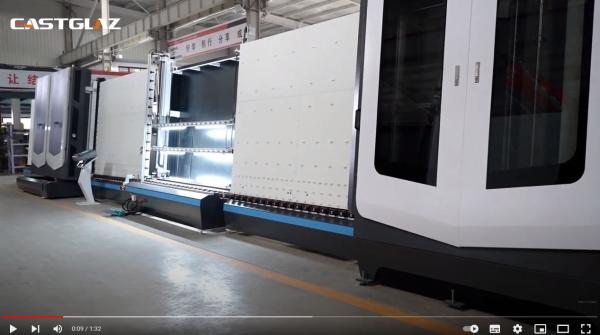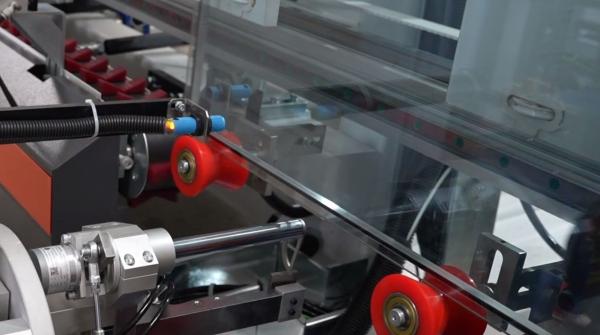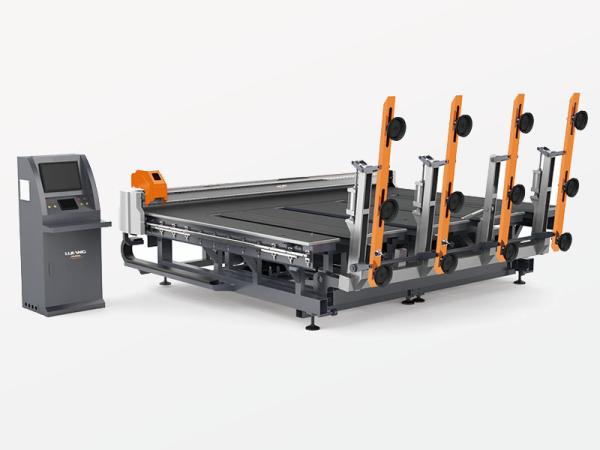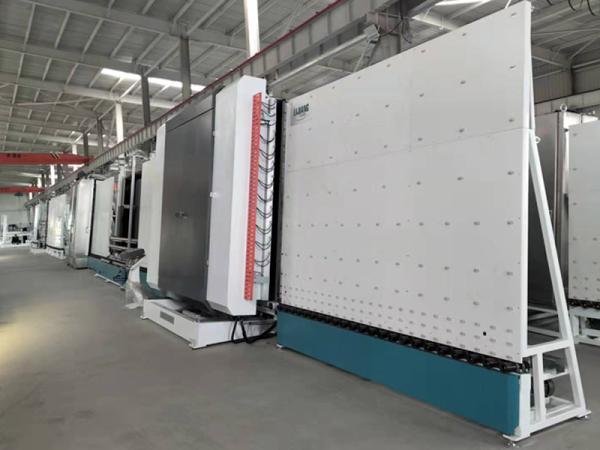Structure and characteristics of a new type of automatic edge breaking device for glass plates

1.1 Overall architecture of the equipment
The device consists of a frame, an edge breaking mechanism, a pressure roller assembly, a cleaning air duct, a chip guide plate and a mobile trolley (Figure 1), which is installed between the front and rear belt conveyors to form a continuous production line. The core functional unit is the edge breaking mechanism, which includes:
• Edge breaking unit: servo motor drives the gear rack to realize horizontal positioning of the upper breaking knife, and pneumatic vertical downward pressure is used to complete the trimming;
• Breaking unit: pneumatically drives the lower breaking knife to vertically lift to achieve glass breaking;
• Polyurethane material tool: avoid glass breakage and meet the needs of high-precision cutting.
1.2 Process flow
1. Front edge trimming: photoelectric sensor locates the glass → lower breaking knife lifts and positions → upper breaking knife presses down to cut the front edge;
2. Continuous breaking: pressure roller dynamically presses down to buffer the impact → lower breaking knife linkage lifts to complete segmentation;
3. Back edge trimming: servo motor drives the upper breaking knife to move horizontally → pneumatic downward pressure to cut the back edge;
4. Debris management: compressed air cleans the surface → chip guide plate collects debris to the mobile trolley.
2. Technological innovation and core design
2.1 Anti-vibration roller system
In view of the problem that small-sized glass is easy to break due to vibration, a dual-roller dynamic adjustment system is designed:
• Arc swing structure: The handwheel drives the roller beam through the reducer to achieve ±15° angle adjustment;
• Flexible contact of rubber-coated roller: The pressure buffer coefficient is >0.8, which effectively disperses the impact force of the lower breaking knife;
• Bilateral symmetrical layout: Adapts to 300~1500mm wide glass to ensure the stability of the breaking process.
2.2 High-precision motion control
• Servo drive system: Planetary reducer + servo motor realizes horizontal positioning of the upper breaking knife (accuracy ±0.1mm);
• Linear guide assembly: Ensure the vertical movement stability of the tool to avoid cracking of the glass edge;
• Intelligent sensor collaboration: Photoelectric sensor and controller are linked to achieve millimeter-level position feedback.
2.3 Integration of cleaning and collection
• Air pressure cleaning module: 0.6MPa compressed air covers the glass surface through an array of air nozzles (cleaning rate ≥95%);
• Funnel-shaped chip guide plate: 45° tilt angle design guides the debris to fall efficiently;
• Mobile debris trolley: 0.5m³ volume + universal wheel structure, supporting rapid cleaning and transportation.
III. Application effect and market prospects
3.1 Performance improvement verification
In the processing test of refrigerator shelf glass (specifications 400×600mm):
• Finished product rate: increased from 92% of traditional manual labor to 99.2%;
• Efficiency: single operation cycle shortened from 25s to 8s;
• Dimensional accuracy: tolerance control ±0.5mm (manual ±2mm).
3.2 Economic Benefit Analysis
• Labor cost: Reduce the need for operators by 60%;
• Increased production capacity: Support 24-hour continuous production, with a daily processing volume of 3,000 pieces;
• Maintenance cost: Modular design reduces fault repair time by 30%.
3.3 Application expansion direction
• Multi-field adaptation: Has been successfully applied to home appliance glass (oven panels, refrigerator shelves), electronic display substrates and other fields;
• Technology upgrade path:
◦ Integrate machine vision positioning system to achieve adaptive processing of non-standard glass;
◦ Develop quick-change tool modules to support 0.5~10mm thick glass processing;
◦ Combined with Industrial Internet of Things (IIoT), build a production data intelligent analysis platform.
IV. Challenges and future prospects
The current device still has limitations such as high initial investment (30%~40% higher than traditional production lines) and insufficient adaptability to ultra-thin glass (<2mm). Future research directions include:
1. Cost optimization: Use lightweight materials (such as carbon fiber) to reduce frame weight and cost;
2. Flexible upgrade: Develop pressure adaptive control system and expand to curved glass processing;
3. Green manufacturing: Develop debris recycling and reuse technology to reduce glass raw material loss.
Conclusion
This study has overcome the problems of vibration breaking, precision control and debris management in the automatic edge breaking of small-sized glass through mechatronics innovation. Practical application shows that the device can significantly improve the intelligence level of glass deep processing production line and provide efficient solutions for precision glass manufacturing in home appliances, electronics and other industries. With subsequent technology iteration and cost optimization, it is expected to become standard equipment in the field of glass deep processing and promote the industry's transformation to high-quality and sustainable development.
 en
en Spanish
Spanish Russian
Russian Arabic
Arabic Portuguese
Portuguese Italian
Italian French
French Turkish
Turkish Vietnamese
Vietnamese Thai
Thai






